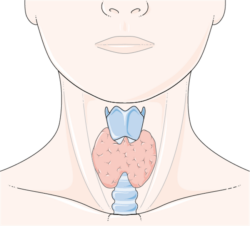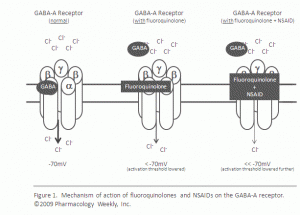“I’ve prescribed fluoroquinolone antibiotics to hundreds of patients and I’ve never seen problems like yours. It’s a good drug with an excellent safety record.”
Some version of that statement is said to many patients who approach doctors with the many symptoms of fluoroquinolone toxicity syndrome. Fluoroquinolones (Cipro/ciprofloxacin, Levaquin/levofloxacin, Avelox/moxifloxacin and Floxin/ofloxacin) have been shown to damage connective tissue (tendons, ligaments, cartilage, fascia, etc.) throughout the body, damage the nervous systems (central, peripheral and autonomic), and lead to multi-symptom, often chronic, illness. Most of the symptoms of fluoroquinolone toxicity are listed on the 43 page warning label for cipro/ciprofloxacin. However, disregard of patients with fluoroquinolone toxicity syndrome is, unfortunately, common. Statements like the one above are wrong-headed and foolish – here’s why:
- The statement of, “I’ve prescribed fluoroquinolone antibiotics to hundreds of patients and I’ve never seen problems like yours” and implying that therefore fluoroquinolones are safe, is an illogical argument based in ego, not fact. Prescribing a drug hundreds of times does not make it a good, or safe, drug. The fact that something has been done millions times before does not mean that it’s the right way to do things. As an example, millions of people were given Vioxx before it was taken off the market because it causes heart attacks and strokes. If a physician never saw a heart attack result from Vioxx use, that doesn’t mean that they didn’t happen. They did. Thousands of people had heart attacks and died because of Vioxx. A history of doing something wrong does not make it right. Implied in the statement that a physician has never seen fluoroquinolone damage is the assumption that what a physician sees is factual and without bias. If a doctor regularly prescribes a drug, he or she is going to believe in its safety and efficacy based on a desire to see him or herself as one who helps patients, regardless of its actual safety and efficacy. Doctors have bias and ego just like the rest of us. Anecdotal evidence, even anecdotal evidence from a doctor, is not able to trump experimental evidence. Drugs need to hold up in scientific experiments and controlled trials – not in the opinion court of doctors. In multiple experiments, fluoroquinolones have been shown to damage cells (by depleting mitochondrial DNA, magnesium, lipids, enzymes, etc.). Science wins every time, and the scientific evidence comes down on the side of fluoroquinolones being dangerous drugs.
- It shows an unwillingness/inability to connect pharmaceutical drugs to multi-symptom diseases. Fluoroquinolones deplete mitochondrial DNA and lead to mitochondrial dysfunction. When mitochondria aren’t functioning properly, cells aren’t functioning properly. Mitochondria are the energy centers of eukaryotic cells – the engines. If cellular engines are malfunctioning, many systems shut down. This shut-down can lead to a cascade of damage – much of it self-perpetuating and difficult to repair. The details of the biochemistry behind this are incredibly complex and difficult, but the basic concept of drugs that cause mitochondrial damage lead to multi-symptom, chronic illness, isn’t so difficult that someone who went through med school shouldn’t be able to grasp it. But many doctors are loathe to admit that the drugs that they prescribe cause mitochondrial damage. Many studies have shown that fluoroquinolones damage mitochondria (HERE and HERE). Even the FDA acknowledges that the mechanism through which fluoroquinolones do damage is through mitochondrial toxicity. Mitochondrial toxicity = multi-symptom, often chronic, illness. It’s not that hard. But if doctors admitted that fluoroquinolones cause multi-symptom, chronic illness, they may have to look at the relationship between all mitochondria damaging drugs (statins, SSRIs and even acetaminophen are on the list along with fluoroquinolones) and the rise in mysterious multi-symptom illnesses. If they did that, they may have to admit that the drugs they prescribed, ‘hundreds of times’ are hurting people – and who wants to do that? It’s much easier to repeat the lie of, “these drugs have an excellent record of safety and efficacy,” than it is to admit to inflicting harm (even inadvertently) on patients.
- They’re not looking at delayed reactions or tolerance thresholds. Despite the fact that both delayed adverse reactions and tolerance thresholds for fluoroquinolones are documented (it all goes back to how mitochondria respond to damage – more HERE), reactions that occur after administration of the drug have stopped are not connected to the drug by many physicians. “It should be out of your system by now,” is repeated often. That may be the case, but the drug set off an intracellular bomb and now the damage is self-perpetuating. Delayed reactions and tolerance thresholds may make recognition of adverse drug reactions difficult, but it doesn’t make them go away. Unfortunately, cells don’t always act as they “should” – they act as they do – with messy things like non-linear reactions, negative feedback loops, etc.
- The specialist model keeps many doctors from seeing the damage that fluoroquinolones cause. For example, ER doctors often prescribe fluoroquinolones because they’re powerful broad-spectrum antibiotics. But when people have an adverse reaction a week later that looks and feels a lot like an autoimmune disease, they’re not going to the ER for treatment because autoimmune-disease-like symptoms are for a rheumatologist or general practitioner to treat, not an ER doctor. This disconnect keeps many doctors from seeing the harm done by fluoroquinolones.
- Statements like, “I’ve prescribed fluoroquinolone antibiotics to hundreds of patients and I’ve never seen problems like yours. It’s a good drug with an excellent safety record.” communicate to patients that a physician’s anecdotal evidence is more important than a patient’s pain. It communicates that it’s okay for side-effects of a drug to be devastating as long as the doctor perceives the adverse reactions as rare. It’s not okay for a doctor to disobey his or her Hippocratic Oath and hurt patients – even inadvertently. And I would argue that adverse reactions to fluoroquinolones are far less rare than anyone would like to believe (arguments HERE and HERE).
- It shows that doctors don’t believe the warning labels on drugs. The warning label for Cipro/ ciprofloxacin is 43 PAGES long and lists many musculoskeletal and nervous system adverse effects of cipro and other fluoroquinolones. Do doctors think that the FDA is just kidding when they put all those adverse effects on the warning label?
- The mantra of, “fluoroquinolones have an excellent safety record” has been repeated so many times that it is assumed to be true. It is not true. There are hundreds of studies showing that fluoroquinolones profoundly damage cells and there are zero studies that show that people are immune to the damage caused by fluoroquinolones. The perception of safety is based on an unwillingness to recognize tolerance thresholds for fluoroquinolones, delayed adverse reactions to fluoroquinolones and the connection between fluoroquinolones and multi-symptom diseases.
- It shows that they’re afraid. Some of the fear is legitimate. Antibiotic resistance is on the rise. If fluoroquinolones are restricted to only being used appropriately – i.e. in life-or-death situations after all other antibiotics have failed – doctors will have fewer tools at their disposal and they may not be able to fight a nasty infection without inflicting cellular damage that results in chronic illness. No one wants to have to choose between an infection and multi-symptom, chronic illness. It would be better to have neither. But if there aren’t any options of antibiotics that don’t cause the cellular damage that leads to oxidative stress and multi-symptom illness… well, that’s a possibility that is too frightening and daunting to think about.
- Too many doctors are attached to lazy medicine – throwing strong, broad-spectrum antibiotics at everyone who comes in the door with an infection (or just a high white blood cell count). If the adverse effects of fluoroquinolones were acknowledged, the pros and cons would have to be careful weighed before administering them. A long discussion with patients about tendon ruptures, peripheral neuropathy, increased chance of diabetes, central nervous system damage, etc., would have to be had along with every prescription for Cipro, Levaquin or Avelox in order for an obligation of informed consent to be met. If broad-spectrum fluoroquinolones couldn’t be thrown at every infection, bacterial cultures would need to be done to figure out exactly what antibiotics would work best. That takes time and money and it’s easier to do things as they have been done – even if it involves denying the damage that fluoroquinolones do. Those pesky tests to make sure that the Hippocratic Oath is upheld may get in the way of business.
Adverse drug reactions don’t stop happening just because they’re inconvenient; or because they’re unrecognized or misdiagnosed. They don’t become rare or insignificant just because they are complicated and difficult to recognize.
Fluoroquinolones are dangerous drugs that damage cells on multiple levels. This has been shown in laboratories many times. The cellular damage caused by fluoroquinolones (along with the destruction of the microbiome) leads to multi-symptom, often chronic, illness. This has been shown by multiple patient reports.
Many doctors haven’t read the memo about how dangerous fluoroquinolones are though. Shouldn’t they know the dangers of the drugs that they prescribe? Shouldn’t they have learned about adverse drug reactions in school? It doesn’t seem like too much to ask for. There are hundreds of studies showing that fluoroquinolones damage eukaryotic cells. Shouldn’t they have read them, or at least been told about them by the FDA?
You’d think so. But the mantra of, “Fluoroquinolones have an excellent record of safety and efficacy” has been repeated so many times that it’s thought to be true just because it’s been heard over and over again. Let’s change the mantra. How about, “fluoroquinolones are dangerous drugs that should only be used in life-or-death situations?” That mantra sounds much better. It’s more appropriate, and it’s closer to the truth. If we keep on repeating it, maybe doctors will start to listen.
We Need Your Help
More people than ever are reading Hormones Matter, a testament to the need for independent voices in health and medicine. We are not funded and accept limited advertising. Unlike many health sites, we don’t force you to purchase a subscription. We believe health information should be open to all. If you read Hormones Matter, like it, please help support it. Contribute now.
Yes, I would like to support Hormones Matter.
This post was first published on October 1, 2014.
Information about Fluoroquinolone Toxicity
Information about the author, and adverse reactions to fluoroquinolone antibiotics (Cipro/ciprofloxacin, Levaquin/levofloxacin, Avelox/moxifloxacin and Floxin/ofloxacin) can be found on Lisa Bloomquist’s site, www.floxiehope.com.
Photo by karatara: https://www.pexels.com/photo/male-statue-decor-931317/






























